Latest News
December 1, 2012
By Pamela J. Waterman
Technology no longer just marches on; it sprints, cuts back, jukes and spins by with incredible speed. The pace of technological innovation makes it tough to tackle. The difficulties keeping up are exacerbated for design engineers who are charged with mastering new hardware, software and processes in order to create the latest high-tech product designs faster and more affordably than ever before.
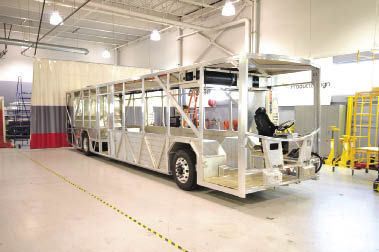 |
| Optimized aluminum bus-frame of fuel-efficient transit bus. Image courtesy Altair ProductDesign. |
Whether your next project shows up on the desk with half the parts already specified, or you’re staring at a blank screen and a specification document, final success depends on many factors. One of these is your company’s ability to match design engineering tasks to the skills of your own staff.
Are you at the point where a new project is pushing the limits of your in-house expertise? Do you require specialized talent for a short period? Or do you have a sense that fresh ideas are just what you need right now? Working with experts who specialize in areas where your team needs help not only speeds up the development cycle, but can offer a whole new objective vision—and inspire improvements you may not have considered.
One such expert is Altair ProductDesign, an international company that has spent almost 30 years crafting and expanding a distinct approach to consulting. As a division of Altair Engineering, Altair ProductDesign comprises more than 40 offices around the world, a fact that offers the first clue that its approach is hardly business as usual.
Enlist Engineering Expertise
In the global economy, the need to differentiate a product drives every aspect of its design. Part count, manufacturing approaches, assembly requirements, material properties, and costs must be constantly reviewed and evaluated. The more complex the product is, the harder it can be, especially under time-to-market pressures. The ideal product includes innovation at every step, and Altair ProductDesign offers this through its simulation-based design optimization process.
Altair Engineering itself started in the mid-1980s as a mechanical engineering consulting company, with both aerospace and automotive clients. Within a year, the company had an on-site office at General Motors, and soon after started design optimization projects on the classic Corvette and the Ford 150 suspension (looking ahead to the 1996 model).
“The automotive and aerospace industries in particular embraced simulation because they needed to reduce the amount of physical testing required to home in on an optimum design,” says Royston Jones, president of Altair ProductDesign. “Gradually, simulation became a tool not just for verification, but to actually lead the design process.”
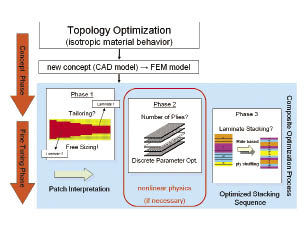 |
| Sample two-phase optimization topology process for use of composites in a structural design process, based on Altair OptiStruct software. Image courtesy Altair ProductDesign. |
By 2008, the division was up to 500 members and had established its first on-site Optimization Center for Airbus in Toulouse, France, supporting all Airbus European efforts.
Early on, Altair recognized the key factors for successful and innovative product development centered on optimizing performance and weight.
“Allowing intelligent simulation technology to inform the early stages of product development is a cornerstone of our simulation-driven design philosophy,” Jones notes. “As companies seek to minimize the material use and weight of their products, combining simulation technology with our own knowledge and creativity helps our clients meet their product performance, fuel efficiency and emissions goals.”
Working with existing simulation packages inspired the development of Altair’s first software product, HyperMesh, later followed by products such as OptiStruct to form the beginnings of HyperWorks, Altair’s full CAE software suite. The suite now comprises more than 15 products for modeling, visualization, analysis and optimization.
Online Resource for Product Weight Reduction Reducing product weight has so many advantages, it’s no wonder that design groups are paying more attention to tools for doing so. Launched in January 2012, AltairEnlighten.com serves as a software-independent online resource for anyone in the industry wanting to learn more about advances in this area. Article and blog topics include material substitution (composites, advanced metallics, joining technology), optimization methods and processes, and new advancements (nanotechnology, additive manufacturing, biomimicry). Peter Roberts, marketing manager for Altair ProductDesign, says it was important to the company to establish a real community beyond just automotive and aerospace. “The whole simulation-driven design philosophy really is something being applied across industries,” he says. “From packaging companies to electronics to heavy vehicles like cranes, I think it’s really picking up a huge amount of momentum, not just in those industries that are perhaps more traditionally looking at weight. The amount of material that is used to make products is becoming more and more of an issue for them. They’re always looking to get production costs down, and this optimization- and simulation-driven design philosophy is really a fantastic way to achieve those goals.”—PJW |
Altair OptiStruct is a finite-element-based package with an internal solver that uses a gradient-based topology approach to developing lightweight, structurally efficient designs that clearly take manufacturability issues into account. Advanced capabilities include optimizing laminate composite ply-up sequences, incorporating multi-disciplinary responses (such as buckling or heat transfer), and dealing with multi-body dynamic systems. The last task is handled via the company’s own Equivalent Static Load Method (ESLM).
For critical projects demanding high-performance design, Altair HyperStudy applies the concepts of design optimization to an even broader range of tasks, from product weight reduction and design of experiments to multidisciplinary studies and stochastic investigations of reliability/robustness factors. HyperStudy is a solver-neutral optimization package with direct interfaces to dozens of popular solvers.
Optimization No Longer Optional
It’s clear that the primary factors driving today’s high-end product designs are outside the control of design engineers. Jones says that since 2008, the waves of financial crises coupled with other factors (such as recent European emission standards) have pushed optimization efforts to the forefront for the automotive industry. Very often, the crux of the design lies with its weight, so Altair ProductDesign consultants specialize in innovative structural-design solutions that minimize weight while maintaining performance requirements.
Working at the component level, the design optimization team may first evaluate the roles of a dozen high-mass components that together comprise the majority of a vehicle’s weight—a front door or seat pedestal, for example. They would then zero in on several critical parts with potential for improvement. Usually, a component’s material (steel or aluminum) and production process (stamping) are pre-defined, so the Altair ProductDesign experts set up dozens to hundreds of optimization runs, varying the geometry parameters of CAD designs subjected to stress analyses. Visualized results can point designers to optimized organic geometries quite different from those based on right angles or traditional symmetry.
More recently, in the continuing search to reduce weights, material properties are being added to the optimization mix. Designers would like to expand the use of composites beyond non-load-bearing and non-safety-related components such as interior linings. For example, Altair ProductDesign helped Volkswagen Group Research investigate a load-bearing composite B-pillar (the industry term for the vertical structural member generally at the vehicle mid-point).
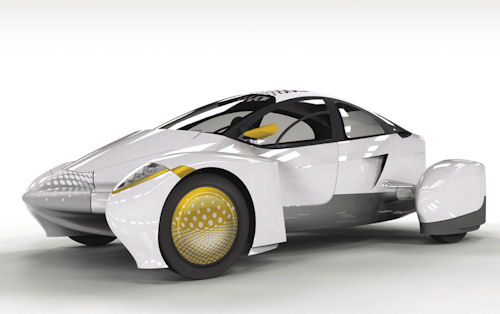 |
| Altair ProductDesign is partnering with Edison2 to design the suspension system and other aspects of the next generation of the 110-mpg design that won $5 million in the 2010 Progressive Automotive X PRIZE competition. Image courtesy Altair ProductDesign. |
The simulation sets included a high number of design variables such as geometry, number of layers and composite fiber orientation; load cases were a static roof crush, a seat-belt anchorage test and a standard side-impact. Allowing for nonlinear (deformation) behavior required two stages of optimization, working first on the load analysis of a linear structure to define geometry, then evaluating nonlinear behavior to define the requisite manufacturing process. Having this development approach in place now allows the Volkswagen research group to methodically evaluate structures that were previously impossible to simulate.
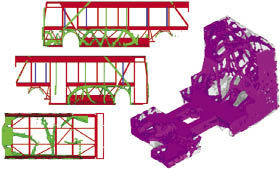 |
| Altair ProductDesign consultants used a simulation-driven approach (including use of Altair HyperWorks software) to develop a bus frame with optimized placement of structural material. The resulting vehicle has a frame that is 30% lighter than conventional vehicles, and has twice the standard fuel efficiency. Image courtesy Altair ProductDesign. |
Lightweight, low-cost design requirements also drive Altair ProductDesign’s partnership with Edison2 in Lynchburg, VA, to assist in the design of the new Very Light Car 4.0 (VLC 4.0). This vehicle will be the next generation of the fuel-efficient (110 mpg) design that won $5 million in the Mainstream Class at the 2010 Progressive Automotive X PRIZE competition. Whereas the original vehicle operated with a one-cylinder internal combustion engine, the new version will be all-electric and carry four passengers.
Altair ProductDesign will conduct a three-phase engineering study, targeting suspension sensitivity, impact strategy and structural optimizations.
“Our engineers will focus on using optimization in the beginning of the design process to anticipate structural loading requirements with a minimum mass structure,” reports Mike Heskitt, chief operating officer for the consultant group. Heskitt adds that Altair’s HyperWorks simulation suite will be used to validate Edison2’s novel suspension concept (supporting more in-wheel suspension travel).
Applying Lessons Learned
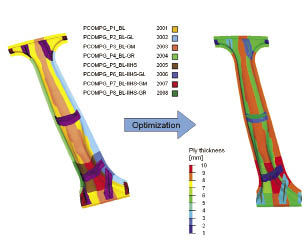 |
| Various designs and manufacturing processes for an optimized composite-material automotive B-pillar (the mid-frame, vertical load-bearing support between windows). The program was developed by Altair ProductDesign for Volkswagen Group Research, to define a general process for designing, analyzing and validating possible composite parts through simulation. Image courtesy Altair ProductDesign. |
While Altair has its roots in the automotive and aerospace industries, optimization expertise isn’t just needed for highly engineered, complex products. Altair ProductDesign is now applying optimization solutions to many different engineering problems.
For example, another of Altair ProductDesign’s customers is Mabe, an international white goods manufacturing company based in Mexico City whose products include a high-end combination washer-dryer. The unit requires packaging that minimizes transport damage while avoiding unnecessary sections that would add material costs and shipping weight. The consulting team was challenged to produce an optimized product-packaging design process based on three goals:
1. derive the best packaging before the product itself was
available for physical testing;
2. take into account a variety of loading scenarios; and
3. be flexible enough to work on a variety of future products.
The consulting team used Altair HyperMesh to create a finite element analysis (FEA) model of both the washer-dryer’s structural components and packaging elements such as laminated paper, corrugated board and polystyrene foam. After conducting simplified performance tests on the packaging, Altair ProductDesign engineers subjected the virtual washer-dryer to the same loads as in physical testing. Using the “onion peel” feature of HyperWorks’ post-processor, HyperView, the group could see internal components and determine the amount of energy absorption shared between the unit and the packaging components.
Because the different packaging materials serve different purposes, it made sense to perform separate topology optimizations on each, maximizing energy transfer, and then translate the results back into the CAD designs. Final results included such improvements as reducing peak reaction forces by 22% through the use of an optimized laminated paper corner-post.
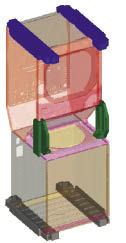 | 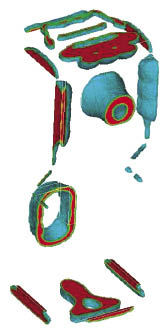 | 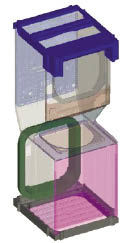 |
| Design process to improve packaging materials/layout for a combination washer-dryer, performed by AltairProductDesign, a division of Altair Engineering. Image courtesy Altair ProductDesign. | ||
Close Partnerships Pay Off
The philosophy of the Altair ProductDesign operations makes its worldwide consulting partnerships collaborative at a close and practical level, with certain core competencies at each office.
“We’ll send one of our engineers to the local customer’s office, or we’ll take one of the local people and put them in the office where we have the expertise,” says Jones. “I want to emphasize how important it is to have that ongoing dialogue with the client, and actually see the eyes of the client.”
With regard to the formal Optimization Centers his division runs, Jones says there are more than 10, with long-established groups at aerospace and automotive companies such as Boeing and Daimler, and new ones at other blue-chip original equipment manufacturers either quietly operating or about to begin in the next few months.
“We’ve waited a long time to realize this vision of simulation-driven design,” he adds. “I’d say particularly over the last year, it’s really gathering momentum. Undoubtedly, simulation-driven design is where it will go in the future.”
Contributing Editor Pamela Waterman, DE’s simulation expert, is an electrical engineer and freelance technical writer based in Arizona. You can send her e-mail to [email protected].
INFO
Subscribe to our FREE magazine, FREE email newsletters or both!
Latest News
About the Author
Pamela Waterman worked as Digital Engineering’s contributing editor for two decades. Contact her via .(JavaScript must be enabled to view this email address).
Follow DE





